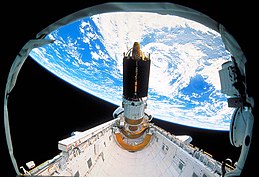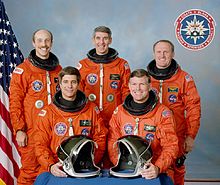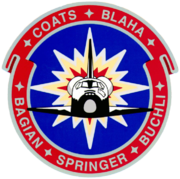STS-29

TDRS-D being deployed on Flight Day 1 of the mission.
|
|
| Mission type | Satellite deployment |
|---|---|
| Operator | NASA |
| COSPAR ID | 1989-021A |
| SATCAT no. | 19882 |
| Mission duration | 4 days, 23 hours, 38 minutes, 52 seconds |
| Distance travelled | 3,200,000 kilometers (2,000,000 mi) |
| Orbits completed | 80 |
| Spacecraft properties | |
| Spacecraft | Space Shuttle Discovery |
| Launch mass | 116,281 kilograms (256,356 lb) |
| Landing mass | 88,353 kilograms (194,785 lb) |
| Payload mass | 17,280 kilograms (38,100 lb) |
| Crew | |
| Crew size | 5 |
| Members |
Michael L. Coats John E. Blaha Robert C. Springer James F. Buchli James P. Bagian |
| Start of mission | |
| Launch date | 13 March 1989, 14:57:00 UTC |
| Launch site | Kennedy LC-39B |
| End of mission | |
| Landing date | 18 March 1989, 14:35:51 UTC |
| Landing site | Edwards Runway 22 |
| Orbital parameters | |
| Reference system | Geocentric |
| Regime | Low Earth |
| Perigee | 297 kilometres (185 mi) |
| Apogee | 308 kilometres (191 mi) |
| Inclination | 28.5 degrees |
| Period | 90.6 min |
 Back row, L-R: Bagian, Springer, Buchli. Front row, L-R: Blaha and Coats. |
|
STS-29 was a NASA Space Shuttle mission, during which Space Shuttle Discovery inserted a Tracking and Data Relay Satellite (TDRS) into Earth orbit. It was the third shuttle mission following the Challenger disaster of 1986, and launched from Kennedy Space Center, Florida, on 13 March 1989. STS-29 was the eighth flight of Discovery and the 28th Space Shuttle mission overall; its planned predecessor, STS-28, was delayed until August 1989.
Discovery lifted off from Pad B, Launch Complex 39, Kennedy Space Center, at 9:57 am EST on 13 March 1989. The launch was originally scheduled for 18 February, but was postponed to allow for the replacement of faulty liquid oxygen turbopumps on the three main engines. The amended target date of 11 March also proved unviable because of the failure of a master event controller when it was powered up during prelaunch checkout; the controller was quickly replaced. On the rescheduled launch day of 13 March, the launch was delayed for nearly two hours because of ground fog and high upper winds. A waiver was approved for the orbiter's wing loads.
The primary payload was the third and final component of the Tracking and Data Relay Satellite (TDRS) constellation in geosynchronous orbit. The three on-orbit satellites were stationed over the equator at about 22,300 miles above Earth; two of them were positioned 130 degrees apart, while the third was located between them as an on-orbit spare.
On Flight Day 1, one of three cryogenic hydrogen tanks which supplied shuttle's electricity-generating fuel cells exhibited erratic pressure fluctuations. It was deactivated while engineers studied the problem, and the crew was told to conserve electrical power. The tank was reactivated on Flight Day 3, 15 March, and operated successfully thereafter.
...
Wikipedia

